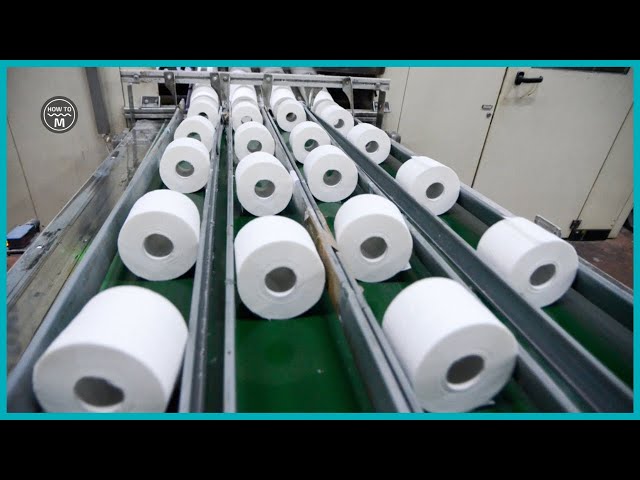The Manufacturing Process of Toilet Paper
Toilet paper is a ubiquitous household item that plays a crucial role in maintaining personal hygiene and cleanliness. While it may seem like a simple product, the manufacturing process behind toilet paper is quite complex, involving various stages and specialized machinery. In this comprehensive article, we will delve into the details of how toilet paper is made, from the raw materials to the final packaged product.
Raw Materials
The primary raw materials used in the production of toilet paper are:
- Pulpwood: Softwood trees such as pine, fir, and spruce are commonly used for their long fibers, which provide strength to the paper. Hardwood trees like oak, maple, and gum are also used for their shorter fibers, which contribute to the softness of the paper. A typical toilet paper blend consists of approximately 70% hardwood and 30% softwood.
- Recycled paper: Post-consumer waste, such as old newspapers, magazines, and office paper, can also be used as a raw material. The recycled paper undergoes a cleaning process to remove contaminants like ink and staples before being processed into pulp.
The Manufacturing Process
The manufacturing process of toilet paper can be divided into several stages:
- Pulping: The raw materials, whether pulpwood or recycled paper, are broken down into a pulp using a combination of mechanical and chemical processes. This involves cooking the wood chips or recycled paper with chemicals and water to separate the fibers.
- Screening and cleaning: The pulp is then screened and cleaned to remove any impurities or contaminants, ensuring a consistent and high-quality product.
- Bleaching: The pulp is bleached to remove any remaining impurities and create a bright, white appearance. Various bleaching agents, such as chlorine dioxide or hydrogen peroxide, are used depending on the manufacturer’s preference and environmental regulations.
- Paper machine: The cleaned and bleached pulp is then fed into a paper machine, where it is diluted with water to create a slurry. This slurry is sprayed onto a moving wire mesh, where the water drains, leaving behind a thin, continuous sheet of paper.
- Pressing and drying: The paper sheet passes through a series of press rolls and dryer cylinders to remove excess moisture and increase its strength and thickness. The temperature and pressure applied during this stage can affect the final texture and softness of the paper.
- Embossing and perforating: The dried paper may undergo embossing, which involves passing it through a set of patterned rollers to create a textured surface. Perforations are also added at regular intervals to facilitate easy tearing of individual sheets.
- Winding and cutting: The large rolls of paper produced by the paper machine are then slit into narrower rolls of the desired width. These rolls are then wound onto cardboard or plastic cores, creating the familiar toilet paper rolls.
- Packaging: The individual rolls are packaged in various ways, such as shrink-wrapping, bundling, or placing them in boxes. The packaging protects the rolls from damage and ensures easy storage and distribution.
Advances in Technology
The toilet paper industry has seen significant advancements in technology over the years, leading to increased efficiency, quality, and sustainability. Some notable developments include:
- Automated processes: Many stages of the manufacturing process, such as pulping, paper machine operation, and packaging, have been automated to reduce human error and increase productivity.
- Recycling initiatives: With growing environmental concerns, manufacturers are increasingly using recycled paper as a raw material, reducing waste and promoting sustainability.
- Eco-friendly products: Some manufacturers are producing toilet paper made from alternative materials like bamboo or sugarcane, which are more environmentally friendly than traditional wood pulp.
- Improved softness and strength: Advancements in embossing and pressing techniques have led to the development of softer and stronger toilet paper, providing a more comfortable user experience.
The Importance of Toilet Paper
Toilet paper is an essential product for maintaining personal hygiene and cleanliness. It plays a significant role in preventing the spread of germs and bacteria, promoting good health and well-being. Additionally, toilet paper provides comfort and convenience, allowing individuals to clean themselves quickly and easily after using the toilet.
Frequently Asked Questions (FAQ)
Q1: What are the main raw materials used in toilet paper production?
The main raw materials used in toilet paper production are pulpwood (softwood and hardwood trees) and recycled paper.
Q2: How is recycled paper processed for toilet paper production?
Recycled paper undergoes a cleaning process to remove contaminants like ink and staples before being processed into pulp.
Q3: What is the purpose of bleaching in toilet paper production?
Bleaching is used to remove any remaining impurities and create a bright, white appearance in the final product.
Q4: How does the embossing process affect the texture of toilet paper?
Embossing involves passing the paper through patterned rollers, creating a textured surface that can affect the softness and feel of the final product.
Q5: Are there any eco-friendly alternatives to traditional toilet paper?
Yes, some manufacturers are producing toilet paper made from alternative materials like bamboo or sugarcane, which are more environmentally friendly than traditional wood pulp.
Summary Table
| Stage | Description |
|---|---|
| Raw Materials | Pulpwood (softwood and hardwood trees), recycled paper |
| Pulping | Breaking down raw materials into pulp using mechanical and chemical processes |
| Screening and Cleaning | Removing impurities and contaminants from the pulp |
| Bleaching | Using bleaching agents to remove remaining impurities and create a bright, white appearance |
| Paper Machine | Spraying pulp slurry onto a wire mesh to create a continuous sheet of paper |
| Pressing and Drying | Removing excess moisture and increasing strength and thickness of the paper |
| Embossing and Perforating | Creating textured surface and perforations for easy tearing |
| Winding and Cutting | Slitting large rolls into narrower rolls and winding them onto cores |
| Packaging | Protecting rolls from damage and ensuring easy storage and distribution |
For more information on the history and development of toilet paper, you can refer to the Wikipedia page on toilet paper.
Conclusion
The manufacturing process of toilet paper is a complex and intricate one, involving various stages and specialized machinery. From the raw materials to the final packaged product, each step plays a crucial role in ensuring the quality and consistency of the final product. As technology continues to advance, the toilet paper industry is adapting to meet the growing demand for eco-friendly and high-quality products, ensuring that this essential household item remains a staple in homes around the world.



